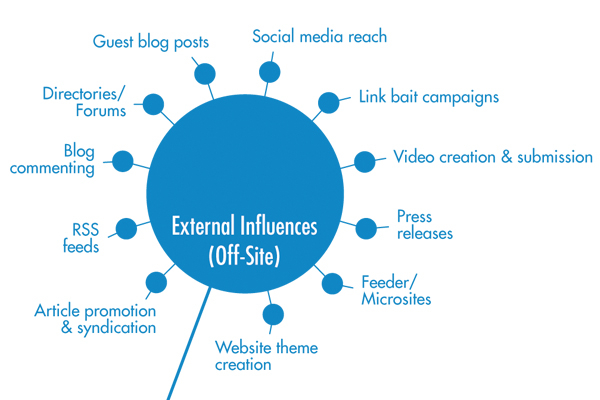
The large majority of external factors that influence organic rankings fall within the classification of link building. There have been great debates in recent months that the ranking impact that can be derived through social media signals falls outside of “traditional” link building. That is valid, and will continue to be debated.
It seems there are few topics within SEO or digital marketing that are as highly contested and controversial as link building. As the SEO Tactics chart was developed, it became obvious that off-site influences would be a core pillar.
This article focuses more on the strategies that surround link building as opposed to the tactics. The space is flooded with these tactics already, yet little attention is paid to the strategies that guide successful link building campaigns.
You are simply burning time and money when a thoughtful link building strategy is absent. Hopefully some of the concepts conveyed in this article will translate well into the programs you’re managing.
Keywords, Anchor Text & the Value of Diversification
You absolutely must have a data-driven keyword strategy in place to drive results from your link building efforts. If you’re not driving revenue or leads then what’s the point?
Identify keywords that have the highest likelihood of driving incremental online conversions, and set those terms as your target. Here’s some good information on identifying the right keywords.
These keywords become the genesis of your anchor text, but don’t fall into the trap that many SEOs do. Here’s a common problem – I want to rank for “men’s jackets” and in doing so I’ve determined that all of the links that I will attain will be targeted with “men’s jackets” as the anchor text. This is a mistake. While you certainly need some focus on the primary keywords within your anchor text it’s equally as important to work with derivatives of that keyword.
Moderation and diversification are important principles in anchor text selection. Do your homework and identify a set of valuable derivates such as “men’s winter jackets” and “cheap men’s jackets.” Diversifying the keywords within your link profile will help it appear natural.
An anchor text usage rule of thumb that we’ve seen success with looks something like this:
- 50 percent containing the exact match keyword.
- 30 percent to 40 percent containing keyword derivatives.
- 10 percent to 20 percent containing brand terms/URL.
Diversification not only relates to the anchor text but to the proportion of “follow” and “nofollow” links within your profile. Many link builders make the mistake of acquiring an abundance of “follow” links to the point where it makes up nearly 100 percent of the profile. Does this look natural? No.
While the direct value of a “nofollow” link will be less than a “follow,” the indirect value of diversifying your overall link profile will make it well worth the time.
Aiming at the Right Target – Destination URL Selection
The link building components of an SEO campaign shouldn’t occur in a vacuum. They should be complimenting a larger and more holistic approach to SEO. When determining the URL that you will be pointing to your anchor text, you should follow the same methodology that your internal linking structure follows.
This consistency is important and will help signal the engines as to which specific URL should rank for a given term. Mapping your keywords to specific URLs from the start is a worthwhile exercise and can be used as a guide for both internal and off-site linking. Here’s some good information related to keyword mapping and on-site optimization elements that should be considered as part of your holistic plan.
Avoid pointing links to the home page when link building to non-brand terms. Diversification again comes into play here and you want URLs that have the best chance of converting to be the page that ranks for a given term.
Strive for a healthy mix of links coming in at you category pages, sub-category pages, and product-level pages. If you are link building with the anchor text “men’s jackets” this should be pointing into your category level page that is optimized for “men’s jackets” with an internal linking structure that is supporting the URL for that keyword.
Sub-category-targeted link building can be quite successful within ecommerce sites. Utilizing a sub-category-specific derivative such as “men’s winter jackets” that is pointed to its mapped sub category URL can be beneficial for both that term and the head term that it is a derivative of. This is where the power of proper internal linking can benefit your link building efforts as weight can be transferred both upstream to the category page and downstream to product-level pages via site navigation, breadcrumbs, etc.
Penalized vs. Devalued – Panda Paranoia
It’s hard to have a discussion on link building without talking about Google’s Panda update. Plenty of ecommerce webmasters are afraid that Google is or will penalize their site because they have links coming in from what they believe is a low quality content site that has been penalized.
Unless you’re creating massive amounts of low quality content on your own site, the chances of you receiving stiff penalties from Google because of a few inbound links is quite low (although a small degree of paranoia is a good thing when it comes to SEO). However, it’s quite likely those inbound links will be devalued. This is a much different scenario than your site being penalized though – so keep things in perspective.
A Couple of Parting Thoughts
Take the time to do this right. Don’t rush into link building without a clear strategy, and don’t think that it’s purely a numbers game.
Relevance and quality really do matter and will set you up for a sustainable link building campaign. Whether you’re acquiring links through blogging, video distribution, infographics, whitepapers, press releases, webinars or distributing articles, always keep your focus on the end user and the value that your content offers them.
